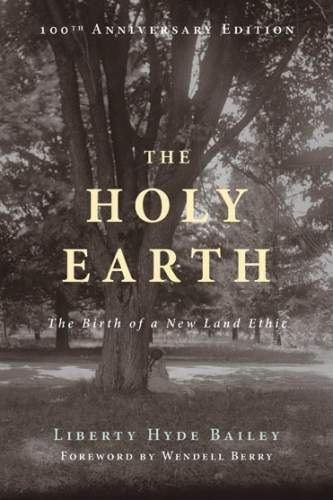by By Liberty Hyde Bailey
Centennial Edition: Foreword by Wendell Berry; edited by Jon Linstrom.
Counterpoint, 2015
A centennial edition of The Holy Earth was recently published, and it brings back the words of Liberty Hyde Bailey (1858-1954), a remarkable individual whose contributions to the well-being of farmers, farms, and rural life should be better known. Born in Michigan, Bailey moved to Ithaca, New York, in 1885. There, he founded the School of Agriculture at Cornell University and became its dean from 1903 to 1913. He wrote over 65 books and at least 1,300 articles.
The Holy Earth was written when Bailey was 57 and it evokes the feeling of sitting with an ancient sage who peels back the layers of life. Many of his observations seem pulled from contemporary life; I was constantly reminding myself that these words were penned over 100 years ago.
The opening section, entitled “First, The Statement,” establishes his basic philosophy: the earth is good; the earth is bountiful; it can be stern, but it is kindly; and above all, “the earth is holy.” And of all the factors that compromise these concepts, “man is the greatest.” Bailey makes clear his view that the resources of the globe must be used in a way that ensures they’ll be available for generations to come. The “dominion over every living thing” taken from the Christian Bible has too often been used to justify exploitation, greed, and waste rather than careful utilization and sound husbandry. He calls for a “new formulation … a vast religion of a better social order.”
Next, Bailey elaborates on the consequences. He decries the devastation brought on by militarism and shows concern for farming becoming a business rather than a way to sustain oneself: “We must be alert to see that it does not lose its capacity for spiritual contact.”
Bailey expresses contempt for the manufactured pharmaceuticals that were becoming the norm. He argues that meat should be curtailed in favor of vegetables and notes that most of the population, including farmers, live from box, bottle, and tin can, not knowing, or caring, who produced the materials. Keep in mind that this was written in 1915.
In another diatribe against greed and waste, he decries how mankind is “mortgaging the future” and “burdening the shoulders of generations yet unborn.”
Not all the book is doom and gloom. Few people have expressed better than Bailey the wonder and joy of the forest, the wind, the song of a forest brook, and the call of a forest bird.
But Bailey did not like the way the world was heading: it was not sustainable, it was destructive, it was spiritually toxic. He was calling for a transformation to a time when the natural world and the agricultural world could work in harmony with one another, just as a tree’s roots, trunk, limbs, and leaves all work toward maximum growth.
If Bailey were writing a second retrospect for the 2015 edition, what thoughts would he share with the world? The “habit of destruction” of the earth’s resources has abated little since his death in 1954. But just as he expressed hope both in 1915 and 1942, he would be encouraged by trends and movements in the current age. Worries about climate change have given new stimulus to taking civilization off the fossil fuel road to ruin. He would be encouraged by the growing interest and development of new agricultural processes, such as organic agriculture, agro-forestry, and permaculture, many of which can be traced back to ancient models. Bailey’s idea of a spiritual revolution, where people find satisfaction and fulfillment by immersing themselves in the wondrous natural world that surrounds us, may yet come to pass.
A version of this review appeared in The North Eastern Holistic Resource, March 2016.


